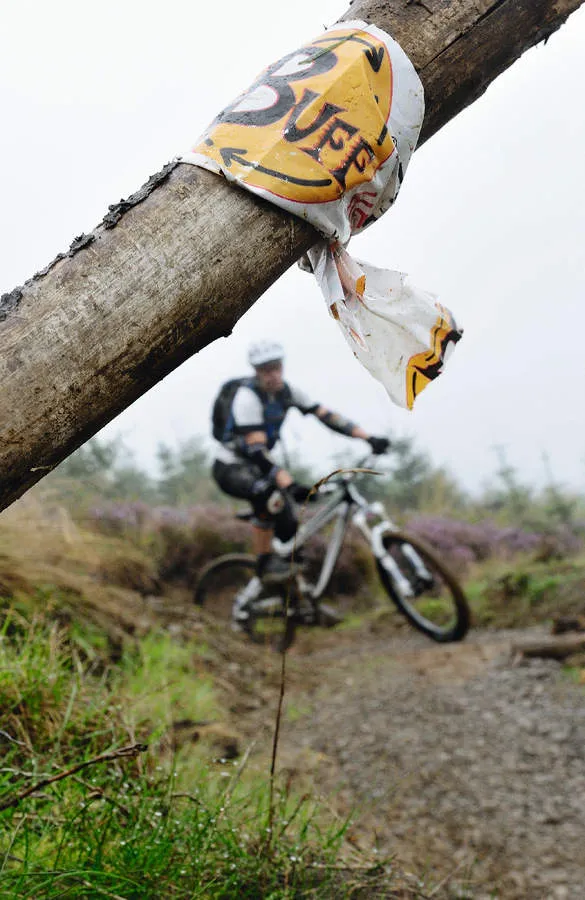Taking control of your vision can have a huge impact on the speed and flow of your riding. But becoming faster isn't just about getting the techniques right, it’s also about practice.
Understanding how vision works
The first step to riding better through vision control is to know how the different parts of our vision work. Here we have to dip into neuroscience, but stick with us as it’s important stuff. Your eyes pick up information through two types of vision – focal and ambient – and these work quite separately, delivering information from the eyes along different pathways to different places in the brain.
Focal vision is concerned with what we look at and is used to identify objects.
Ambient vision picks up information from everything that is in front of us, within range of the eyes.
While focal vision takes time to decide where to look then process the information, ambient vision is instant and unconscious because we don’t think about what it sees, we just see it and react to it. Think broadband vision – it’s always on, always working.
Ambient vision is most important for movement control and for managing our bodies as we adjust to changes in balance or our environment. Think about walking down the road and sending a text. You rely totally on focal vision to write the text, but at the same time you rely totally on ambient vision to see where you are going and not trip or bump into things.
Mountain biking as an applied science
Understanding the science means we can now apply it to the trails. The way to do this is to use each visual system to best effect, to keep us fast, smooth and safe.
Focal vision allows us to look ahead, scan for specific objects or trail sections that we need to prepare for. We know focal vision is relatively slow, so we have to look ahead to give our eyes time to move and focus, then our brain time to process. The faster you go, the less time you have, so you need to look further ahead.
Ambient vision allows us to see the trail as it approaches us and to control our reaction to that trail. Our ambient vision works quickly and keeps us balanced, so we have to trust it to do its job. We still need good body position and footwork, but with those things in place it’s our ambient vision that gets us through with speed, balance and good control.
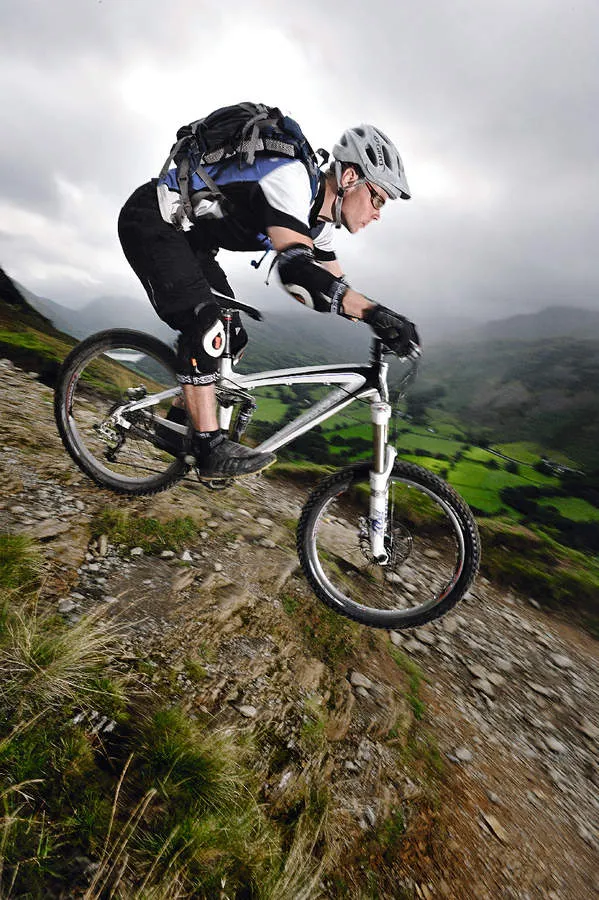
Managing focal vision
The biggest problem most riders face is letting their focus gradually get sucked in to the front wheel. Often this happens when you spot a big rock way ahead, then watch it all the way until you hit it. Instead of letting your focal vision hand over to your ambient vision as the terrain approaches, you find yourself looking down, out of control and not ready for what comes next.
To change this you need to look at the trail in bite-sized chunks, or sections. For example, a corner would be a section, or a rock garden, or a jumble of tree roots – any manageable feature, obstacle or defined part of the trail can be called a section. Now follow these simple rules:
- Before entering a section look right through it, scanning the trail quickly for any major features
- Once in the section, make sure you look to the exit and down the trail beyond it
- As you approach the exit, focus on the entry to the next section
The idea is to train your focal vision to keep moving ahead of you, and breaking the trail up into chunks like this gives you clear points for your eyes to aim for. For example, as soon as you enter a tight turn you are rotating your head and shoulders to look for the exit. In the second half of the turn you are choosing your line through to the next trail section.
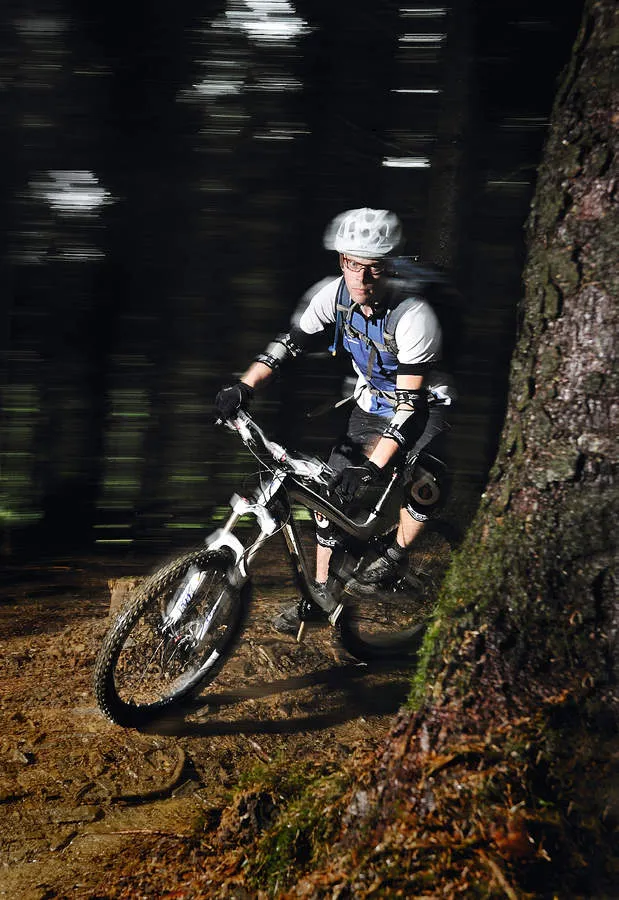
Getting faster with vision control
One of the most exciting things about improving your vision is the effect it can have on your speed. If you have a trail you ride often, and know you have the skills to clean it, try working on your vision to ride it faster and faster.
1. First look at how it breaks into sections.
2. Then, as you ride it, try to move your focus ahead of you, section by section, and allow your ambient vision to control your instant, intuitive reactions to the trail as it reaches you.
3. Next think about the places where you use your brakes, and why. Often, braking is the result of information overload as the trail comes at you too fast - you can’t process it, you start to feel out of control, so you hit the brakes.
But there’s an alternative to slowing down – pull in the information sooner and give yourself more time to process it. In other words, just as you reach for the levers, try looking further down the trail instead. Trust your ambient vision to handle what you’re about to hit and start working your focal vision on the obstacles further ahead.
Head control affects vision control
Head movements affect balance and the more rapid the movement, or if it is combined with the feet being unstable, the greater the impact on balance. This is partly caused by the disruption to the inner ear but also by the effect of rapid movements on your vision. If you can ensure that your head and shoulders flow smoothly down the trail, whatever your arms and legs are doing, you’ll retain good vision.
This is where vision ties in closely to good footwork and body position. You need relaxed arms and legs, elbows low and bent, knees bent, hips flexible and ready to move – every part of your body needs to absorb the shocks from the trail so your torso and head can move calmly and quickly forwards.
When it all works and you feel as though the trail is approaching you at a sensible speed, even though you’re riding faster than ever before, then you know you’ve got vision control mastered.
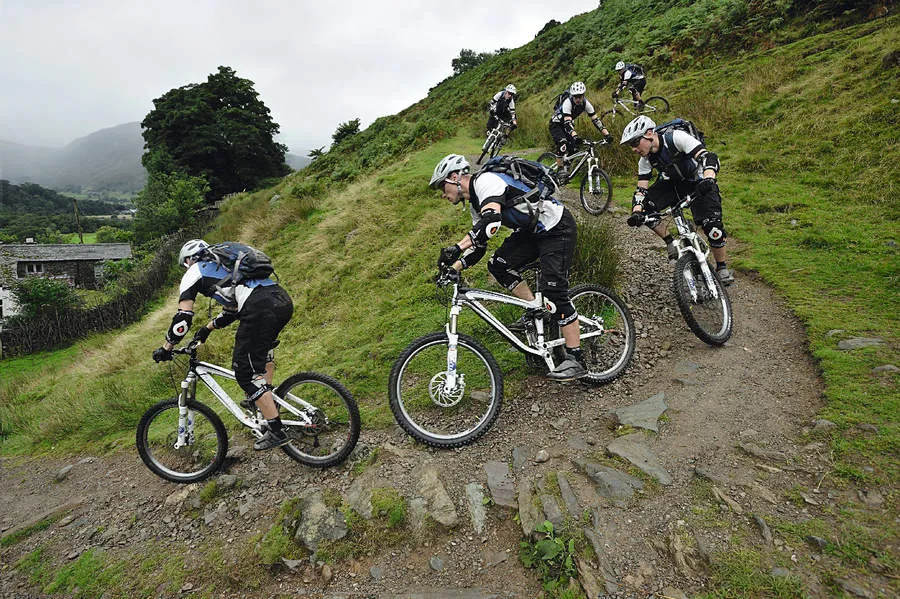
Looking ahead and picking your line is key to smooth cornering
Cornering
- Scan the trail: As you straighten up and get into a comfortable position for high-speed riding, start to scan ahead and use your focal vision to check for obstacles and select a line to deal with them effectively.
- Look ahead: Approaching the exit of the last turn you can look far down the trail, trusting your ambient vision to get you through the rest of the turn as you start to pick up speed.
- Prepare for the next turn: Once a turn is coming to an end you need to be looking through the trail towards the next section, in this case a second switchback, and figuring out your entry line, speed and body setup.
- Look through: As you enter a turn section look through the trail to get your line and start to figure out your exit route.
- Lead with your head: By turning your head and shoulders you can lean the bike more effectively through the turn, as well as making sure you look for your exit point in good time. Weight is centred on the bike, not back, to ensure good front wheel grip.
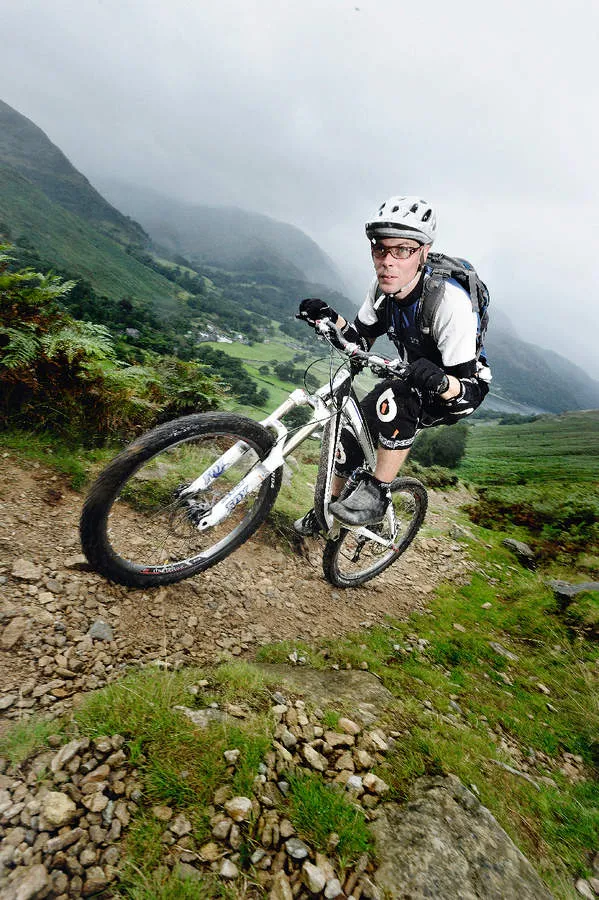
Keep your weight low for max traction and, remember, eyes on the trail
Climbing
- Chin up: With your head forward keep your chin up and look ahead, not down at the front wheel. Line choice is important and you also need to plan for surges of energy to get over steps or steep sections.
- Weight the wheel: Keep your chest low and forwards to ensure the front wheel has enough weight over it to keep it on the trail and tracking straight.
- Keep it smooth: Smooth application of power through good pedalling technique is vital on steep, loose, long climbs like this. It also lets you sit fairly still, allowing your focal vision to work more effectively as you select your lines.
- On the nose: Slide forwards on the saddle and sit right on the nose. It’s not always comfortable but it lets you maintain traction and still stretch your body forwards.
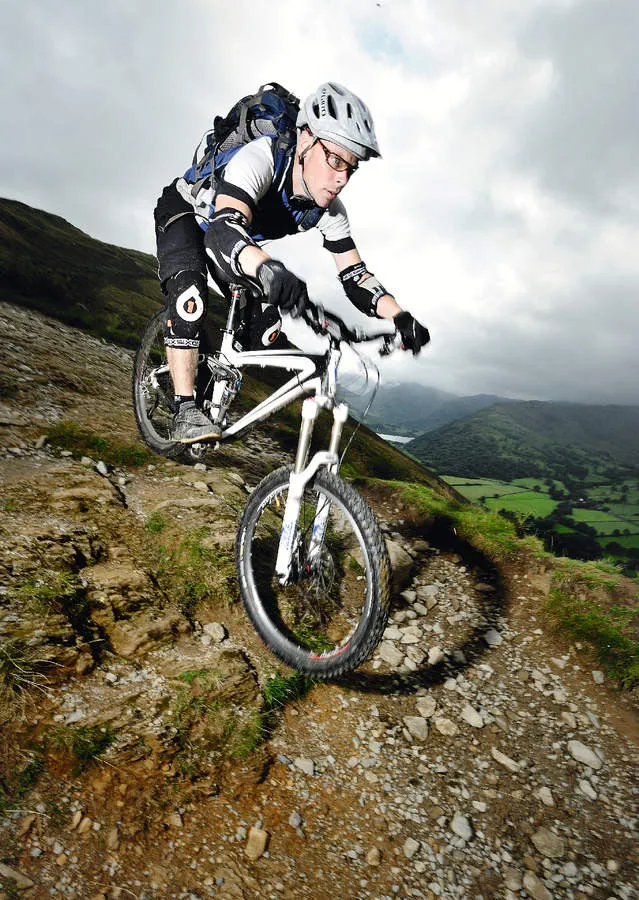
Shift your weigh back, chest low, arms flexed and look well ahead
Drop-offs
- Drop your heels: Keep your heels down on steep roll-offs for maximum grip on the pedals and good control of bike and body as you accelerate forward then hit the bottom.
- Trust yourself: Let your ambient vision do all the close control work as you focus ahead, knowing that you will pick up speed at the bottom of the drop.
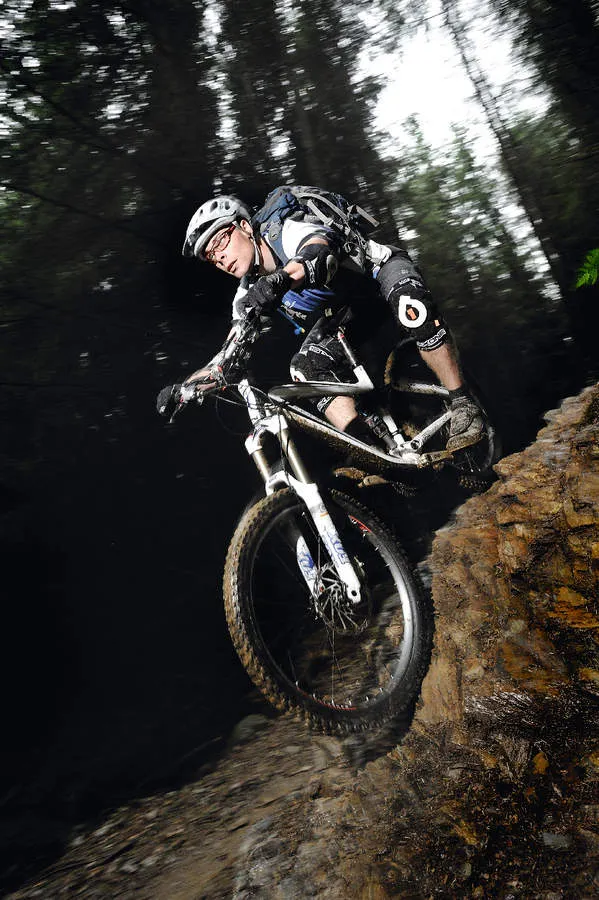
Focus as far ahead as possible to give your brain time to react
Steep descents
- Night rider: In low light your ambient vision improves while focal vision slows down, so even in dark, rocky terrain you must look ahead and not down at the trail below or just in front of you.
- Eyes up: You can see the front of your front tyre even if you don’t look at it, so look ahead and trust your balance and your bike to handle the rocks that are under you already.
- Set up for smoothness: With body pushed back and chest low you can keep your arms flexible, ensuring that all bumps are absorbed and your head and upper body move smoothly down the trail.
- Stable platforms: Keep your cranks level and heels down so your feet will stay firmly on the pedals, even on steep and rocky terrain.
Top tips for practicing vision control
Get a focus: When sessioning a trail section get a friend to stand round the corner, or at the bottom of a slope, and look to them as soon as you can. If you’re alone take some tape and tie it to a tree or rock as a focal vision marker.
The right pack: If you use a rucksack make sure it’s bike specific. These are designed to sit lower on your back than regular packs, so when you tip your head back it doesn’t interfere with your helmet and restrict your vision. Also, be sure to tighten waist and chest straps on descents so the pack doesn’t bounce up and hit your helmet.
Set-up tips for good vision control
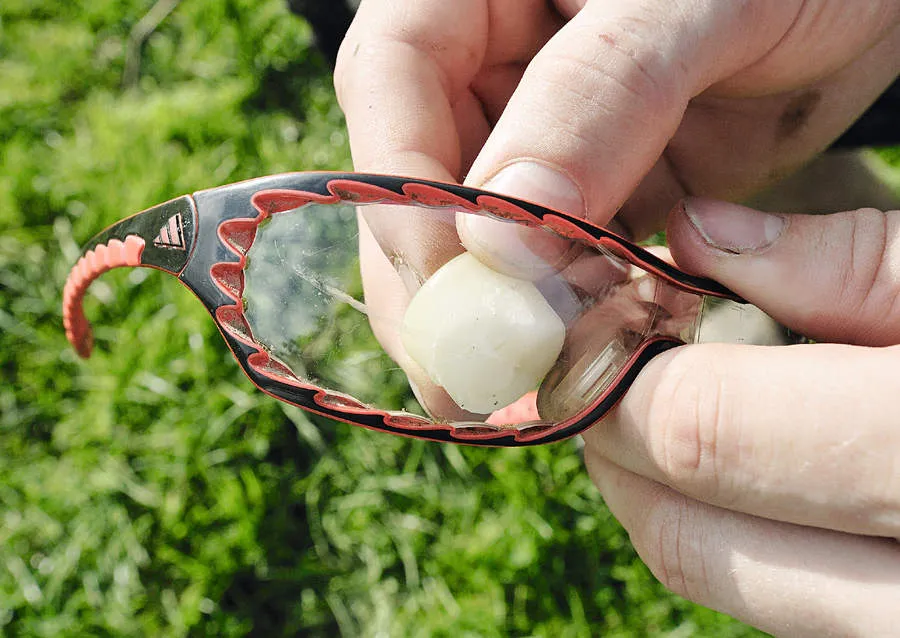
Wax up: Wet, dirty and misted-up glasses make seeing the trail that much harder, so take steps to protect your vision. To keep lenses cleaner, mist-free and better at shedding raindrops you can wax them up. First get them perfectly clean, then rub a bit of candle wax on both sides, polish it on with kitchen paper or lint-free cloth, then reapply and polish again to make sure you have a good coating. This makes a huge difference, especially on steamy winter rides. Don’t even think about hitting the trails without glasses, or you’ll get all manner of muck in your eyes.
Get the low view: Dropping your saddle for descents lets you sink your body lower on the bike, without getting bucked forwards suddenly if the back wheel hits larger rocks. In training this lets you take a bolder approach to rough terrain as you learn to trust your ambient vision without worrying about larger obstacles. But there’s another effect – by bringing your eyes down and back you get a better view of the trail hitting your wheel than you would if your head was high over the bars. This improves your unconscious bike handling and reduces the temptation to tilt your head down.

Meet Our Coaching Expert
Chris founded his company, CycleActive, in 1996 and set out to create a professional training and travel operation. He was the first to employ only qualified, professional instructors and now his team leads the way in delivering skills coaching.
Recently Chris has been working closely with the CTC on its MTB Instruction programme, using fundamental elements of this as part of his feature. Combined with his own research on vision in mountain biking, his level 4 coach status as an SMBLA tutor, expedition and night riding instructor, this really sets him apart as a coach – making him the perfect author for this What Mountain Bike series.
To find out about coaching or group courses with Chris and his team, visit www.cycleactive.co.uk.
